029057连续变量量子信息
连续变量量子密钥

连续变量量子密钥连续变量量子密钥通常是指用连续变量量子系统来实现量子密钥分发和量子密钥分发协议。
在传统的量子密钥分发中,通常使用离散变量量子系统,如量子比特,来进行信息传输和密钥分发。
然而,连续变量量子密钥的提出,为量子通信和量子密钥分发带来了新的可能性。
连续变量量子密钥分发的基本原理是利用连续变量量子系统中的连续变量来编码和传输密钥信息。
连续变量通常指的是量子系统中的连续物理量,如光的相位和振幅。
相比于离散变量,连续变量具有更高的信息传输速率和更低的实验要求,因此在量子通信中具有重要的应用价值。
在连续变量量子密钥分发中,通信双方通常使用光的连续变量来编码密钥信息。
通过光的相位和振幅的调制,发送方可以将密钥信息编码到光的连续变量中,并将其发送给接收方。
接收方通过测量光的连续变量,可以获取到发送方编码的密钥信息。
由于量子系统的本质,任何对光的连续变量的测量都会对其状态造成不可避免的扰动,因此,即使是被窃听的量子信道,也可以通过特定的协议来检测到窃听行为,并确保密钥的安全性。
在连续变量量子密钥分发中,最常用的协议是基于连续变量的一次态密度矩阵编码协议(CV-MDI-QKD)。
该协议通过发送和接收方的相互配合,实现了密钥信息的编码和传输。
发送方首先对密钥信息进行编码,然后将编码后的光信号发送给接收方。
接收方在接收到光信号后,通过测量光的连续变量,获取到发送方编码的密钥信息。
最后,发送方和接收方通过公开的经典信道,对测量结果进行比较和纠错,以确保密钥的一致性和安全性。
除了CV-MDI-QKD协议,还有其他一些基于连续变量的量子密钥分发协议,如基于连续变量的双向量子密钥分发协议(CV-BB84),基于连续变量的量子反馈协议(CV-QFB),以及基于连续变量的量子密钥分发协议(CV-QKD)。
这些协议都是基于连续变量的量子系统进行的密钥分发,具有不同的特点和应用场景。
总结起来,连续变量量子密钥是利用连续变量量子系统进行密钥分发和传输的一种方法。
量子力学新进展III-连续变量
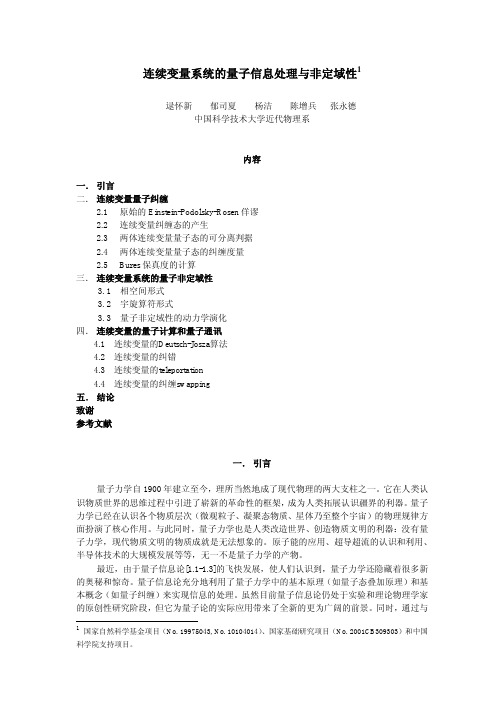
(2.6)
NOPA =
其中, q n = 2 n! π
n
1 ∞ (tanh r )n ∫ dq ∫ dq' q, q' q, q' n, n . ∑ cosh r n =0
(2.7)
(
)
−1 / 2
H n ( q) exp( − q 2 / 2), H n 为 Hermite 多项式。利用求和公式
q 2 + q' 2 −2λqq' , exp λ q n n q' = ∑ − 2(1 − λ2 ) n =0 π (1 − λ2 )
对于 50/50 分束器,且 N
= 1 , 出态为
1 2
( 0,1
+ 1,0 ) .
(b) n1 , n2 = n, n , 对于 50/50 分束器, 输出态
1 ˆ n, n = e − i ( n − 2 m ) φ B ∑ 2 m =0
n
n n
∑ (−1)
k =0
n− k
n n (2m)!(2n − 2m)! 2m,2n − 2m . k n! 2m − k
1
2
ˆ n1 , n 2 N1 , N 2 B
n2
= e −iφ ( n1 − N1 ) ∑∑ ( −1) n1 −k r n1 +n2 −k −l t k +l
k =0 l = 0
n1
(2.13)
×
n1! n2 ! N 1! N 2 ! δ N ,n + k −l δ N 2 ,n1 −k + l N 1 , N 2 . k! (n1 − k )! l! ( n2 − l )! 1 2
连续变量量子密钥分配

连续变量量子密钥分配
赵义博
【期刊名称】《量子光学学报》
【年(卷),期】2006(12)B08
【摘要】分离变量量子密钥分配已被提出许多年,不过由于需要用单光子探测器
并且需要接近理想的单光子源而使其密钥分配速度和安全距离都有很大限制。
最近,作为一种变通的方案,采用零拍探测和相干态的连续变量被提出了,连续变量被认为是潜在能提供高速密钥量的方案,而且由于探测成本低,安全距离远而受到了广泛关注,本文重点要讲连续变量的具体原理和实际存在的难点。
【总页数】1页(P11-11)
【关键词】量子密钥分配;连续变量;单光子探测器;安全距离;分离变量;单光子源;近
理想;相干态;密钥量;成本低
【作者】赵义博
【作者单位】中国科学技术大学量子信息重点实验室,安徽合肥230026
【正文语种】中文
【中图分类】O241.84;TN918
【相关文献】
1.连续变量量子密钥分配的量化预处理 [J], 郑平允;黄春晖
2.基于量子远程通信的连续变量量子确定性密钥分配协议 [J], 宋汉冲;龚黎华;周南润
3.平衡零拍测量对连续变量量子密钥分配的影响 [J], 陈进建;韩正甫;赵义博;桂有珍;郭光灿
4.海盐粒子半径对大气连续变量量子密钥分配的影响 [J], 张淑静; 肖晨; 武斌; 张海龙
5.实际温度下的大气信道连续变量量子密钥分配 [J], 张淑静;肖晨;张海龙
因版权原因,仅展示原文概要,查看原文内容请购买。
连续变量量子计算领域最新研究
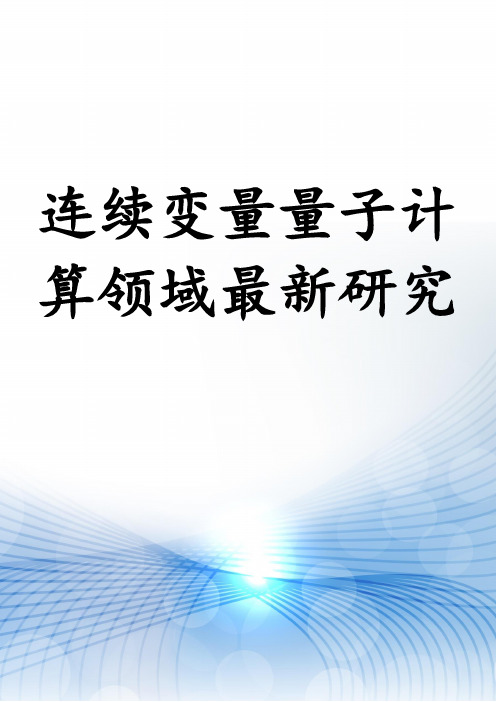
连续变量量子计算领域最新研究连续变量量子计算(Continuous Variable Quantum Computing, CVQC)作为量子信息处理的一个重要分支,近年来在理论研究与实验技术上均取得了显著进展,为解决经典计算机难以处理的复杂问题提供了全新的视角。
以下是关于连续变量量子计算领域最新研究的六个关键点概述:一、量子光学平台的发展量子光学是连续变量量子计算的主要实验实现平台,其中光子作为量子比特具有无质量、高速度和低损耗的天然优势。
最新的研究集中在提高光量子处理器的集成度和稳定性上,比如利用集成光子学技术开发出的量子光子芯片,不仅能够实现量子态的精确操控,还能在微型化设备中集成复杂的量子网络。
这些进展为实现大规模量子计算奠定了物理基础。
二、高维编码与量子纠错为了增强量子信息的抗噪能力并提高计算效率,研究人员在连续变量系统中探索高维编码方案。
不同于传统的二进制编码,高维编码利用量子系统的多个自由度(如光子的轨道角动量、频率或相位)来编码量子信息,从而增加信息密度和处理能力。
同时,针对连续变量系统的量子纠错码也在不断发展,如GKP码和猫态码等,旨在保护量子信息免受环境噪声影响,提升量子算法的鲁棒性。
三、量子纠缠与量子通信量子纠缠是量子计算和量子通信的核心资源。
在连续变量体系中,产生和维持大尺度、高质量的纠缠态是研究重点。
最近的研究展示了通过量子频率梳技术、光参量过程等手段,成功生成了远距离纠缠光子对,并在光纤网络中实现了纠缠分发,为构建量子互联网和分布式量子计算网络提供了可能。
此外,连续变量系统在量子密钥分发中的应用也日益受到重视,提高了信息传输的安全性。
四、量子算法与应用探索随着硬件技术的进步,连续变量量子计算在特定算法和应用领域的探索也更加深入。
例如,在量子优化问题中,连续变量变分量子算法(CV-VQA)被用于寻找复杂优化问题的全局最小值,展示出了超越经典算法的潜力。
在模拟领域,连续变量量子系统特别适合模拟量子场论和量子化学问题,通过量子电路模拟哈密顿量,研究人员已经能初步解决一些小分子的电子结构计算问题。
连续变量量子模拟和对抗量子通信中退相干的实验研究
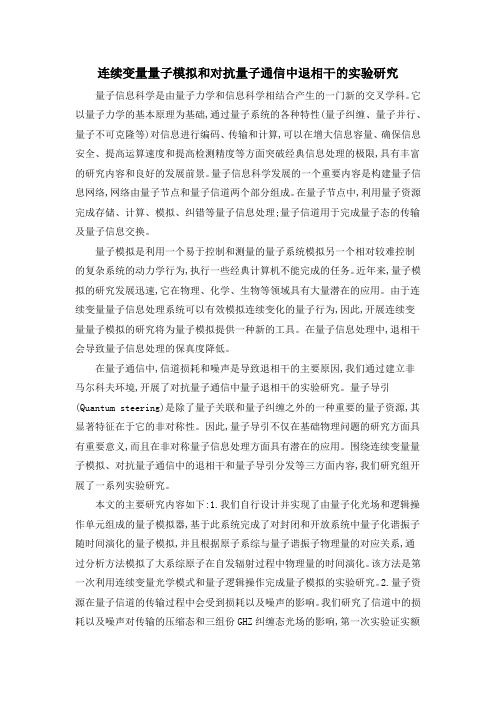
连续变量量子模拟和对抗量子通信中退相干的实验研究量子信息科学是由量子力学和信息科学相结合产生的一门新的交叉学科。
它以量子力学的基本原理为基础,通过量子系统的各种特性(量子纠缠、量子并行、量子不可克隆等)对信息进行编码、传输和计算,可以在增大信息容量、确保信息安全、提高运算速度和提高检测精度等方面突破经典信息处理的极限,具有丰富的研究内容和良好的发展前景。
量子信息科学发展的一个重要内容是构建量子信息网络,网络由量子节点和量子信道两个部分组成。
在量子节点中,利用量子资源完成存储、计算、模拟、纠错等量子信息处理;量子信道用于完成量子态的传输及量子信息交换。
量子模拟是利用一个易于控制和测量的量子系统模拟另一个相对较难控制的复杂系统的动力学行为,执行一些经典计算机不能完成的任务。
近年来,量子模拟的研究发展迅速,它在物理、化学、生物等领域具有大量潜在的应用。
由于连续变量量子信息处理系统可以有效模拟连续变化的量子行为,因此,开展连续变量量子模拟的研究将为量子模拟提供一种新的工具。
在量子信息处理中,退相干会导致量子信息处理的保真度降低。
在量子通信中,信道损耗和噪声是导致退相干的主要原因,我们通过建立非马尔科夫环境,开展了对抗量子通信中量子退相干的实验研究。
量子导引(Quantum steering)是除了量子关联和量子纠缠之外的一种重要的量子资源,其显著特征在于它的非对称性。
因此,量子导引不仅在基础物理问题的研究方面具有重要意义,而且在非对称量子信息处理方面具有潜在的应用。
围绕连续变量量子模拟、对抗量子通信中的退相干和量子导引分发等三方面内容,我们研究组开展了一系列实验研究。
本文的主要研究内容如下:1.我们自行设计并实现了由量子化光场和逻辑操作单元组成的量子模拟器,基于此系统完成了对封闭和开放系统中量子化谐振子随时间演化的量子模拟,并且根据原子系综与量子谐振子物理量的对应关系,通过分析方法模拟了大系综原子在自发辐射过程中物理量的时间演化。
连续变量量子通信
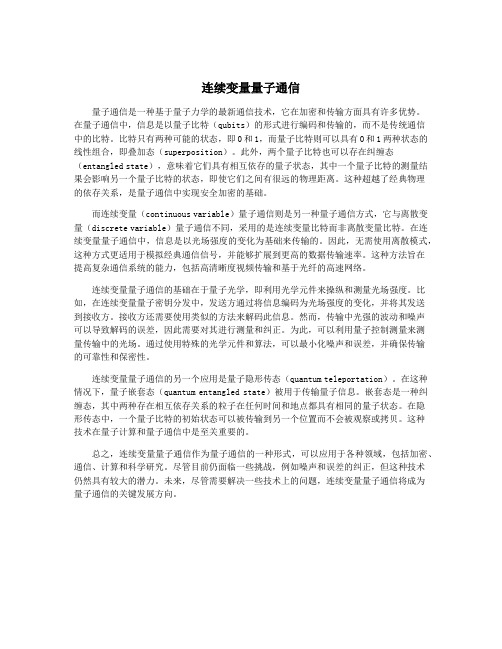
连续变量量子通信量子通信是一种基于量子力学的最新通信技术,它在加密和传输方面具有许多优势。
在量子通信中,信息是以量子比特(qubits)的形式进行编码和传输的,而不是传统通信中的比特。
比特只有两种可能的状态,即0和1,而量子比特则可以具有0和1两种状态的线性组合,即叠加态(superposition)。
此外,两个量子比特也可以存在纠缠态(entangled state),意味着它们具有相互依存的量子状态,其中一个量子比特的测量结果会影响另一个量子比特的状态,即使它们之间有很远的物理距离。
这种超越了经典物理的依存关系,是量子通信中实现安全加密的基础。
而连续变量(continuous variable)量子通信则是另一种量子通信方式,它与离散变量(discrete variable)量子通信不同,采用的是连续变量比特而非离散变量比特。
在连续变量量子通信中,信息是以光场强度的变化为基础来传输的。
因此,无需使用离散模式,这种方式更适用于模拟经典通信信号,并能够扩展到更高的数据传输速率。
这种方法旨在提高复杂通信系统的能力,包括高清晰度视频传输和基于光纤的高速网络。
连续变量量子通信的基础在于量子光学,即利用光学元件来操纵和测量光场强度。
比如,在连续变量量子密钥分发中,发送方通过将信息编码为光场强度的变化,并将其发送到接收方。
接收方还需要使用类似的方法来解码此信息。
然而,传输中光强的波动和噪声可以导致解码的误差,因此需要对其进行测量和纠正。
为此,可以利用量子控制测量来测量传输中的光场。
通过使用特殊的光学元件和算法,可以最小化噪声和误差,并确保传输的可靠性和保密性。
连续变量量子通信的另一个应用是量子隐形传态(quantum teleportation)。
在这种情况下,量子嵌套态(quantum entangled state)被用于传输量子信息。
嵌套态是一种纠缠态,其中两种存在相互依存关系的粒子在任何时间和地点都具有相同的量子状态。
量子信息——连续变量篇
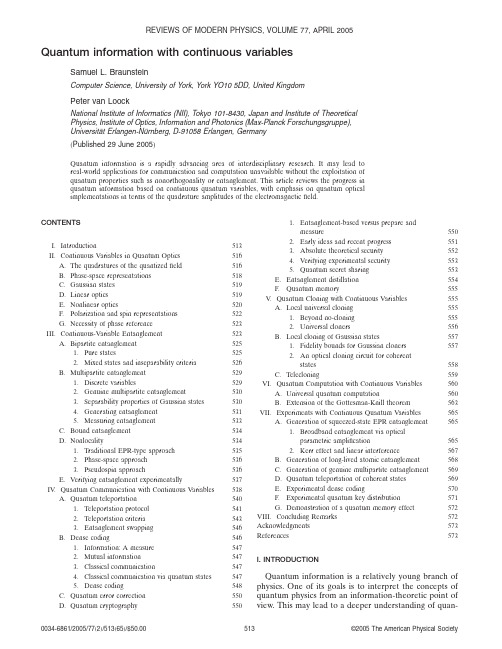
Quantum information with continuous variablesSamuel L.BraunsteinComputer Science,University of York,York YO105DD,United KingdomPeter van LoockNational Institute of Informatics(NII),Tokyo101-8430,Japan and Institute of TheoreticalPhysics,Institute of Optics,Information and Photonics(Max-Planck Forschungsgruppe),Universität Erlangen-Nürnberg,D-91058Erlangen,Germany͑Published29June2005͒Quantum information is a rapidly advancing area of interdisciplinary research.It may lead to real-world applications for communication and computation unavailable without the exploitation of quantum properties such as nonorthogonality or entanglement.This article reviews the progress in quantum information based on continuous quantum variables,with emphasis on quantum optical implementations in terms of the quadrature amplitudes of the electromagneticfield.CONTENTSI.Introduction513II.Continuous Variables in Quantum Optics516A.The quadratures of the quantizedfield516B.Phase-space representations518C.Gaussian states519D.Linear optics519E.Nonlinear optics520F.Polarization and spin representations522G.Necessity of phase reference523 III.Continuous-Variable Entanglement523A.Bipartite entanglement5251.Pure states5252.Mixed states and inseparability criteria526B.Multipartite entanglement5291.Discrete variables5292.Genuine multipartite entanglement5303.Separability properties of Gaussian states5304.Generating entanglement5315.Measuring entanglement533C.Bound entanglement534D.Nonlocality5341.Traditional EPR-type approach5352.Phase-space approach5363.Pseudospin approach536E.Verifying entanglement experimentally537 IV.Quantum Communication with Continuous Variables538A.Quantum teleportation5401.Teleportation protocol5412.Teleportation criteria5433.Entanglement swapping546B.Dense coding546rmation:A measure5472.Mutual information5473.Classical communication5474.Classical communication via quantum states5475.Dense coding548C.Quantum error correction550D.Quantum cryptography5501.Entanglement-based versus prepare andmeasure5502.Early ideas and recent progress5513.Absolute theoretical security5524.Verifying experimental security5535.Quantum secret sharing553E.Entanglement distillation554F.Quantum memory555V.Quantum Cloning with Continuous Variables555A.Local universal cloning5551.Beyond no-cloning5552.Universal cloners556B.Local cloning of Gaussian states5571.Fidelity bounds for Gaussian cloners5572.An optical cloning circuit for coherentstates558C.Telecloning559 VI.Quantum Computation with Continuous Variables560A.Universal quantum computation560B.Extension of the Gottesman-Knill theorem563 VII.Experiments with Continuous Quantum Variables565A.Generation of squeezed-state EPR entanglement5651.Broadband entanglement via opticalparametric amplification5652.Kerr effect and linear interference567B.Generation of long-lived atomic entanglement568C.Generation of genuine multipartite entanglement569D.Quantum teleportation of coherent states569E.Experimental dense coding570F.Experimental quantum key distribution571G.Demonstration of a quantum memory effect572 VIII.Concluding Remarks572 Acknowledgments573 References573I.INTRODUCTIONQuantum information is a relatively young branch of physics.One of its goals is to interpret the concepts of quantum physics from an information-theoretic point of view.This may lead to a deeper understanding of quan-REVIEWS OF MODERN PHYSICS,VOLUME77,APRIL20050034-6861/2005/77͑2͒/513͑65͒/$50.00©2005The American Physical Society513tum theory.Conversely,information and computation are intrinsically physical concepts,since they rely on physical systems in which information is stored and by means of which information is processed or transmitted. Hence physical concepts,and at a more fundamental level quantum physical concepts,must be incorporated in a theory of information and computation.Further-more,the exploitation of quantum effects may even prove beneficial for various kinds of information pro-cessing and communication.The most prominent ex-amples of this are quantum computation and quantum key distribution.Quantum computation means in par-ticular cases,in principle,computation faster than any known classical computation.Quantum key distribution makes possible,in principle,unconditionally secure communication as opposed to communication based on classical key distribution.From a conceptual point of view,it is illuminating to consider continuous quantum variables in quantum in-formation theory.This includes the extension of quan-tum communication protocols from discrete to continu-ous variables and hence fromfinite to infinite dimensions.For instance,the original discrete-variable quantum teleportation protocol for qubits and other finite-dimensional systems͑Bennett et al.,1993͒was soon after its publication translated into the continuous-variable setting͑Vaidman,1994͒.The main motivation for dealing with continuous variables in quantum infor-mation,however,originated in a more practical observa-tion:efficient implementation of the essential steps in quantum communication protocols,namely,preparing, unitarily manipulating,and measuring͑entangled͒quan-tum states,is achievable in quantum optics utilizing con-tinuous quadrature amplitudes of the quantized electro-magneticfield.For example,the tools for measuring a quadrature with near-unit efficiency or for displacing an optical mode in phase space are provided by homodyne-detection and feedforward techniques,respectively. Continuous-variable entanglement can be efficiently produced using squeezed light͓in which the squeezing of a quadrature’s quantumfluctuations is due to a non-linear optical interaction͑Walls and Milburn,1994͔͒and linear optics.A valuable feature of quantum optical implementa-tions based upon continuous variables,related to their high efficiency,is their unconditionalness.Quantum re-sources such as entangled states emerge from the non-linear optical interaction of a laser with a crystal͑supple-mented if necessary by some linear optics͒in an unconditional fashion,i.e.,every inverse bandwidth time.This unconditionalness is hard to obtain in discrete-variable qubit-based implementations using single-photon states.In that case,the desired prepara-tion due to the nonlinear optical interaction depends on particular͑coincidence͒measurement results ruling out the unwanted͑in particular,vacuum͒contributions in the outgoing state vector.However,the unconditional-ness of the continuous-variable implementations has its price:it is at the expense of the quality of the entangle-ment of the prepared states.This entanglement and hence any entanglement-based quantum protocol is al-ways imperfect,the degree of imperfection depending on the amount of squeezing of the laser light involved. Good quality and performance require large squeezing which is technologically demanding,but to a certain ex-tent͓about10dB͑Wu et al.,1986͔͒already state of the art.Of course,in continuous-variable protocols that do not rely on entanglement,for instance,coherent-state-based quantum key distribution,these imperfections do not occur.To summarize,in the most commonly used optical ap-proaches,the continuous-variable implementations al-ways work pretty well͑and hence efficiently and uncon-ditionally͒,but never perfectly.Their discrete-variable counterparts only work sometimes͑conditioned upon rare successful events͒,but they succeed,in principle, perfectly.A similar tradeoff occurs when optical quan-tum states are sent through noisy channels͑opticalfi-bers͒,for example,in a realistic quantum key distribu-tion scenario.Subject to losses,the continuous-variable states accumulate noise and emerge at the receiver as contaminated versions of the sender’s input states.The discrete-variable quantum information encoded in single-photon states is reliably conveyed for each photon that is not absorbed during transmission.Due to the recent results of Knill,Laflamme,and Mil-burn͑Knill et al.,2001͒,it is now known that efficient quantum information processing is possible,in principle, solely by means of linear optics.Their scheme is formu-lated in a discrete-variable setting in which the quantum information is encoded in single-photon states.Apart from entangled auxiliary photon states,generated off-line without restriction to linear optics,conditional dy-namics͑feedforward͒is the essential ingredient in mak-ing this approach work.Universal quantum gates such as a controlled-NOT gate can,in principle,be built using this scheme without need of any Kerr-type nonlinear op-tical interaction͑corresponding to an interaction Hamil-tonian quartic in the optical modes’annihilation and creation operators͒.This Kerr-type interaction would be hard to obtain on the level of single photons.However, the off-line generation of the complicated auxiliary states needed in the Knill-Laflamme-Milburn scheme seems impractical too.Similarly,in the continuous-variable setting,when it comes to more advanced quantum information proto-cols,such as universal quantum computation or,in a communication scenario,entanglement distillation,it turns out that tools more sophisticated than mere Gaussian operations are needed.In fact,the Gaussian operations are effectively those described by interaction Hamiltonians at most quadratic in the optical modes’annihilation and creation operators,thus leading to lin-ear input-output relations as in beam-splitter or squeez-ing transformations.Gaussian operations,mapping Gaussian states onto Gaussian states,also include ho-modyne detections and phase-space displacements.In contrast,the non-Gaussian operations required for ad-vanced continuous-variable quantum communication͑in particular,long-distance communication based on en-514S.L.Braunstein and P.van Loock:Quantum information with continuous variables Rev.Mod.Phys.,Vol.77,No.2,April2005tanglement distillation and swapping,quantum memory,and teleportation͒are due either to at least cubic non-linear optical interactions or to conditional transforma-tions depending on non-Gaussian measurements such asphoton counting.It seems that,at this very sophisticatedlevel,the difficulties and requirements of the discrete-and continuous-variable implementations are analogous.In this review,our aim is to highlight the strengths ofthe continuous-variable approaches to quantum infor-mation processing.Therefore we focus on those proto-cols that are based on Gaussian states and their feasiblemanipulation through Gaussian operations.This leads tocontinuous-variable proposals for the implementation ofthe simplest quantum communication protocols,such asquantum teleportation and quantum key distribution,and includes the efficient generation and detection ofcontinuous-variable entanglement.Before dealing with quantum communication andcomputation,in Sec.II,wefirst introduce continuousquantum variables within the framework of quantumoptics.The discussions about the quadratures of quan-tized electromagnetic modes,about phase-space repre-sentations,and about Gaussian states include the nota-tions and conventions that we use throughout thisarticle.We conclude Sec.II with a few remarks on linearand nonlinear optics,on alternative polarization andspin representations,and on the necessity of a phasereference in continuous-variable implementations.Thenotion of entanglement,indispensable in many quantumprotocols,is described in Sec.III in the context of con-tinuous variables.We discuss pure and mixed entangledstates,entanglement between two͑bipartite͒and be-tween many͑multipartite͒parties,and so-called bound ͑undistillable͒entanglement.The generation,measure-ment,and verification͑both theoretical and experimen-tal͒of continuous-variable entanglement are here of par-ticular interest.As for the properties of the continuous-variable entangled states related with theirinseparability,we explain how the nonlocal character ofthese states is revealed.This involves,for instance,vio-lations of Bell-type inequalities imposed by local real-ism.Such violations,however,cannot occur when themeasurements considered are exclusively of continuous-variable type.This is due to the strict positivity of theWigner function of the Gaussian continuous-variable en-tangled states,which allows for a hidden-variable de-scription in terms of the quadrature observables.In Sec.IV,we describe the conceptually and practi-cally most important quantum communication protocols formulated in terms of continuous variables and thus utilizing the continuous-variable͑entangled͒states. These schemes include quantum teleportation and en-tanglement swapping͑teleportation of entanglement͒, quantum͑super͒dense coding,quantum error correc-tion,quantum cryptography,and entanglement distilla-tion.Since quantum teleportation based on nonmaxi-mum continuous-variable entanglement,usingfinitely squeezed two-mode squeezed states,is always imperfect, teleportation criteria are needed both for the theoretical and for the experimental verification.As is known from classical communication,light,propagating at high speed and offering a broad range of different frequen-cies,is an ideal carrier for the transmission of informa-tion.This applies to quantum communication as well. However,light is less suited for the storage of informa-tion.In order to store quantum information,for in-stance,at the intermediate stations in a quantum re-peater,atoms are more appropriate media than light. Significantly,as another motivation to deal with continu-ous variables,a feasible light-atom interface can be built via free-space interaction of light with an atomic en-semble based on the alternative polarization and spin-type variables.No strong cavity QED coupling is needed as with single photons.The concepts of this transfer of quantum information from light to atoms and vice versa, as the essential ingredients of a quantum memory,are discussed in Sec.IV.FSection V is devoted to quantum cloning with con-tinuous variables.One of the most fundamental͑and historically one of thefirst͒“laws”of quantum informa-tion theory is the so-called no-cloning theorem͑Dieks, 1982;Wootters and Zurek,1982͒.It forbids the exact copying of arbitrary quantum states.However,arbitrary quantum states can be copied approximately,and the resemblance͑in mathematical terms,the overlap orfi-delity͒between the clones may attain an optimal value independent of the original states.Such optimal cloning can be accomplished locally by sending the original states͑together with some auxiliary system͒through a local unitary quantum circuit.Optimal cloning of Gauss-ian continuous-variable states appears to be more inter-esting than that of general continuous-variable states, because the latter can be mimicked by a simple coin toss.We describe a non-entanglement-based implemen-tation for the optimal local cloning of Gaussian continuous-variable states.In addition,for Gaussian continuous-variable states,an optical implementation exists of optimal cloning at a distance͑telecloning͒.In this case,the optimality requires entanglement.The cor-responding multiparty entanglement is again producible with nonlinear optics͑squeezed light͒and linear optics ͑beam splitters͒.Quantum computation over continuous variables,dis-cussed in Sec.VI,is a more subtle issue than the in some sense straightforward continuous-variable extensions of quantum communication protocols.Atfirst sight,con-tinuous variables do not appear well suited for the pro-cessing of digital information in a computation.On the other hand,a continuous-variable quantum state having an infinite-dimensional spectrum of eigenstates contains a vast amount of quantum information.Hence it might be promising to adjust the continuous-variable states theoretically to the task of computation͑for instance,by discretization͒and yet to exploit their continuous-variable character experimentally in efficient͑optical͒implementations.We explain in Sec.VI why universal quantum computation over continuous variables re-quires Hamiltonians at least cubic in the position and momentum͑quadrature͒operators.Similarly,any quan-tum circuit that consists exclusively of unitary gates from515S.L.Braunstein and P.van Loock:Quantum information with continuous variables Rev.Mod.Phys.,Vol.77,No.2,April2005the continuous-variable Clifford group can be efficientlysimulated by purely classical means.This is acontinuous-variable extension of the discrete-variableGottesman-Knill theorem in which the Clifford groupelements include gates such as the Hadamard͑in thecontinuous-variable case,Fourier͒transform or the con-trolled NOT͑CNOT͒.The theorem applies,for example,to quantum teleportation which is fully describable by CNOT’s and Hadamard͑or Fourier͒transforms of some eigenstates supplemented by measurements in thateigenbasis and spin or phaseflip operations͑or phase-space displacements͒.Before some concluding remarks in Sec.VIII,wepresent some of the experimental approaches to squeez-ing of light and squeezed-state entanglement generationin Sec.VII.A.Both quadratic and quartic optical nonlin-earities are suitable for this,namely,parametric downconversion and the Kerr effect,respectively.Quantumteleportation experiments that have been performed al-ready based on continuous-variable squeezed-state en-tanglement are described in Sec.VII.D.In Sec.VII,wefurther discuss experiments with long-lived atomic en-tanglement,with genuine multipartite entanglement ofoptical modes,experimental dense coding,experimentalquantum key distribution,and the demonstration of aquantum memory effect.II.CONTINUOUS VARIABLES IN QUANTUM OPTICSFor the transition from classical to quantum mechan-ics,the position and momentum observables of the par-ticles turn into noncommuting Hermitian operators inthe Hamiltonian.In quantum optics,the quantized elec-tromagnetic modes correspond to quantum harmonicoscillators.The modes’quadratures play the roles of theoscillators’position and momentum operators obeyingan analogous Heisenberg uncertainty relation.A.The quadratures of the quantizedfieldFrom the Hamiltonian of a quantum harmonic oscil-lator expressed in terms of͑dimensionless͒creation and annihilation operators and representing a single mode k, Hˆk=បk͑aˆk†aˆk+12͒,we obtain the well-known form writ-ten in terms of“position”and“momentum”operators ͑unit mass͒,Hˆk=12͑pˆk2+k2xˆk2͒,͑1͒withaˆk=1ͱ2បk͑k xˆk+ipˆk͒,͑2͒aˆk†=1ͱ2បk͑k xˆk−ipˆk͒,͑3͒or,conversely,xˆk=ͱប2k͑aˆk+aˆk†͒,͑4͒pˆk=−iͱបk2͑aˆk−aˆk†͒.͑5͒Here,we have used the well-known commutation rela-tion for position and momentum,͓xˆk,pˆkЈ͔=iប␦kkЈ,͑6͒which is consistent with the bosonic commutation rela-tions͓aˆk,aˆkЈ†͔=␦kkЈ,͓aˆk,aˆkЈ͔=0.In Eq.͑2͒,we see that up to normalization factors the position and the momentum are the real and imaginary parts of the annihilation op-erator.Let us now define the dimensionless pair of con-jugate variables,Xˆkϵͱk2បxˆk=Re aˆk,Pˆkϵ1ͱ2បk pˆk=Im aˆk.͑7͒Their commutation relation is then͓Xˆk,PˆkЈ͔=i2␦kkЈ.͑8͒In other words,the dimensionless position and momen-tum operators,Xˆk and Pˆk,are defined as if we setប=1/2.These operators represent the quadratures of a single mode k,in classical terms corresponding to the real and imaginary parts of the oscillator’s complex am-plitude.In the following,by using͑Xˆ,Pˆ͒or equivalently ͑xˆ,pˆ͒,we shall always refer to these dimensionless quadratures as playing the roles of position and momen-tum.Hence͑xˆ,pˆ͒will also stand for a conjugate pair of dimensionless quadratures.The Heisenberg uncertainty relation,expressed in terms of the variances of two arbitrary noncommuting observables Aˆand Bˆfor an arbitrary given quantum state,͗͑⌬Aˆ͒2͘ϵŠ͑Aˆ−͗Aˆ͒͘2‹=͗Aˆ2͘−͗Aˆ͘2,͗͑⌬Bˆ͒2͘ϵŠ͑Bˆ−͗Bˆ͒͘2‹=͗Bˆ2͘−͗Bˆ͘2,͑9͒becomes͗͑⌬Aˆ͒2͗͑͘⌬Bˆ͒2͘ജ14͉͓͗Aˆ,Bˆ͔͉͘2.͑10͒Inserting Eq.͑8͒into Eq.͑10͒yields the uncertainty re-lation for a pair of conjugate quadrature observables of a single mode k,xˆk=͑aˆk+aˆk†͒/2,pˆk=͑aˆk−aˆk†͒/2i,͑11͒namely,͗͑⌬xˆk͒2͗͑͘⌬pˆk͒2͘ജ14͉͓͗xˆk,pˆk͔͉͘2=116.͑12͒Thus,in our units,the quadrature variance for a vacuum or coherent state of a single mode is1/4.Let us further516S.L.Braunstein and P.van Loock:Quantum information with continuous variables Rev.Mod.Phys.,Vol.77,No.2,April2005illuminate the meaning of the quadratures by looking at a single frequency mode of the electric field ͑for a single polarization ͒,E ˆk ͑r ,t ͒=E 0͓a ˆk ei ͑k ·r −k t ͒+a ˆk †e −i ͑k ·r −k t ͔͒.͑13͒The constant E 0contains all the dimensional prefactors.By using Eq.͑11͒,we can rewrite the mode asE ˆk ͑r ,t ͒=2E 0͓x ˆk cos ͑k t −k ·r ͒+pˆk sin ͑k t −k ·r ͔͒.͑14͒Clearly,the position and momentum operators xˆk and p ˆk represent the in-phase and out-of-phase components of the electric-field amplitude of the single mode k with respect to a ͑classical ͒reference wave ϰcos ͑k t −k ·r ͒.The choice of the phase of this wave is arbitrary,of course,and a more general reference wave would lead us to the single-mode descriptionE ˆk ͑r ,t ͒=2E 0͓x ˆk ͑⌰͒cos ͑k t −k ·r −⌰͒+pˆk ͑⌰͒sin ͑k t −k ·r −⌰͔͒,͑15͒with the more general quadraturesxˆk ͑⌰͒=͑a ˆk e −i ⌰+a ˆk †e +i ⌰͒/2,͑16͒p ˆk ͑⌰͒=͑a ˆk e −i ⌰−a ˆk †e +i ⌰͒/2i .͑17͒These new quadratures can be obtained from x ˆk and p ˆk via the rotationͩx ˆk ͑⌰͒pˆk ͑⌰͒ͪ=ͩcos ⌰sin ⌰−sin ⌰cos ⌰ͪͩxˆk pˆk ͪ.͑18͒Since this is a unitary transformation,we again end upwith a pair of conjugate observables fulfilling the com-mutation relation ͑8͒.Furthermore,because pˆk ͑⌰͒=x ˆk ͑⌰+/2͒,the whole continuum of quadratures is cov-ered by x ˆk ͑⌰͒with ⌰͓0,͒.This continuum of observ-ables is indeed measurable by relatively simple means.Such a so-called homodyne detection works as follows.A photodetector measuring an electromagnetic mode converts the photons into electrons and hence into an electric current,called the photocurrent i ˆ.It is therefore sensible to assume i ˆϰn ˆ=a ˆ†a ˆor i ˆ=qaˆ†a ˆwhere q is a con-stant ͑Paul,1995͒.In order to detect a quadrature of themode aˆ,the mode must be combined with an intense local oscillator at a 50:50beam splitter.The local oscil-lator is assumed to be in a coherent state with large photon number,͉␣LO ͘.It is therefore reasonable to de-scribe this oscillator by a classical complex amplitude␣LO rather than by an annihilation operator aˆLO .The two output modes of the beam splitter,͑aˆLO +a ˆ͒/ͱ2and ͑a ˆLO −a ˆ͒/ͱ2͑see Sec.II.D ͒,may then be approximated byaˆ1=͑␣LO +a ˆ͒/ͱ2,aˆ2=͑␣LO −a ˆ͒/ͱ2.͑19͒This yields the photocurrentsi ˆ1=qa ˆ1†aˆ1=q ͑␣LO *+a ˆ†͒͑␣LO +a ˆ͒/2,i ˆ2=qa ˆ2†aˆ2=q ͑␣LO *−a ˆ†͒͑␣LO −a ˆ͒/2.͑20͒The actual quantity to be measured will be the differ-ence photocurrent␦i ˆϵi ˆ1−i ˆ2=q ͑␣LO *aˆ+␣LO a ˆ†͒.͑21͒By introducing the phase ⌰of the local oscillator,␣LO=͉␣LO ͉exp ͑i ⌰͒,we recognize that the quadrature observ-able xˆ͑⌰͒from Eq.͑16͒is measured ͑without mode index k ͒.Now adjustment of the local oscillator’s phase ⌰͓0,͔enables us to detect any quadrature from thewhole continuum of quadratures xˆ͑⌰͒.A possible way to realize quantum tomography ͑Leonhardt,1997͒,i.e.,the reconstruction of the mode’s quantum state given by its Wigner function,relies on this measurement method,called ͑balanced ͒homodyne detection .A broadband rather than a single-mode description of homodyne de-tection can be found in the work of Braunstein and Crouch ͑1991͒,who also investigate the influence of a quantized local oscillator.We have now seen that it is not too hard to measure the quadratures of an electromagnetic mode.Unitary transformations such as quadrature displacements ͑phase-space displacements ͒can also be relatively easily performed via the so-called feedforward technique,as opposed to,for example,photon number displacements.This simplicity and the high efficiency when measuring and manipulating continuous quadratures are the main reasons why continuous-variable schemes appear more attractive than those based on discrete variables such as the photon number.In the following,we shall refer mainly to the conju-gate pair of quadratures xˆk and p ˆk ͑position and momen-tum,i.e.,⌰=0and ⌰=/2͒.In terms of these quadra-tures,the number operator becomesn ˆk =a ˆk †a ˆk =x ˆk 2+p ˆk 2−12,͑22͒using Eq.͑8͒.Let us finally review some useful formulas for the single-mode quadrature eigenstates,xˆ͉x ͘=x ͉x ͘,pˆ͉p ͘=p ͉p ͘,͑23͒where we have now dropped the mode index k .They are orthogonal,͗x ͉x Ј͘=␦͑x −x Ј͒,͗p ͉p Ј͘=␦͑p −p Ј͒,͑24͒and complete,͵−ϱϱ͉x ͗͘x ͉dx =1,͵−ϱϱ͉p ͗͘p ͉dp =1.͑25͒Just as for position and momentum eigenstates,the quadrature eigenstates are mutually related to each other by a Fourier transformation,͉x ͘=1ͱ͵−ϱϱe −2ixp ͉p ͘dp ,͑26͒517S.L.Braunstein and P .van Loock:Quantum information with continuous variablesRev.Mod.Phys.,Vol.77,No.2,April 2005͉p͘=1ͱ͵−ϱϱe+2ixp͉x͘dx.͑27͒Despite being unphysical and not square integrable,the quadrature eigenstates can be very useful in calculations involving the wave functions͑x͒=͗x͉͘,etc.,and inidealized quantum communication protocols based on continuous variables.For instance,a vacuum state infi-nitely squeezed in position may be expressed by a zero-position eigenstate͉x=0͘=͉͐p͘dp/ͱ.The physical,fi-nitely squeezed states are characterized by the quadrature probability distributions͉͑x͉͒2,etc.,ofwhich the widths correspond to the quadrature uncer-tainties.B.Phase-space representationsThe Wigner function is particularly suitable as a “quantum phase-space distribution”for describing the effects on the quadrature observables that may arise from quantum theory and classical statistics.It behaves partly as a classical probability distribution,thus en-abling us to calculate measurable quantities such as mean values and variances of the quadratures in a classical-like fashion.On the other hand,in contrast to a classical probability distribution,the Wigner function can become negative.The Wigner function was originally proposed by Wigner in his1932paper“On the quantum correction for thermodynamic equilibrium”͑Wigner,1932͒.There, he gave an expression for the Wigner function in terms of the position basis which reads͑with x and p being a dimensionless pair of quadratures in our units withប=1/2as introduced in the previous section;Wigner, 1932͒W͑x,p͒=2͵dye+4iyp͗x−y͉ˆ͉x+y͘.͑28͒Here and throughout,unless otherwise specified,the in-tegration will be over the entire space of the integration variable͑i.e.,here the integration goes from−ϱtoϱ͒. We gave Wigner’s original formula for only one mode or one particle͓Wigner’s͑1932͒original equation was in N-particle form͔because it simplifies the understanding of the concept behind the Wigner function approach. The extension to N modes is straightforward.Why does W͑x,p͒resemble a classical-like probability distribution?The most important attributes that explain this are the proper normalization,͵W͑␣͒d2␣=1,͑29͒the property of yielding the correct marginal distribu-tions,͵W͑x,p͒dx=͗p͉ˆ͉p͘,͵W͑x,p͒dp=͗x͉ˆ͉x͘,͑30͒and the equivalence to a probability distribution in clas-sical averaging when mean values of a certain class of operators Aˆin a quantum stateˆare to be calculated,͗Aˆ͘=Tr͑ˆAˆ͒=͵W͑␣͒A͑␣͒d2␣,͑31͒with a function A͑␣͒related to the operator Aˆ.The measure of integration is in our case d2␣=d͑Re␣͒d͑Im␣͒=dxdp with W͑␣=x+ip͒ϵW͑x,p͒,and we shall use d2␣and dxdp interchangeably.The opera-tor Aˆrepresents a particular class of functions of aˆand aˆ†or xˆand pˆ.The marginal distribution for p,͗p͉ˆ͉p͘,is obtained by changing the integration variables͑x−y =u,x+y=v͒and using Eq.͑26͒,that for x,͗x͉ˆ͉x͘,by using͐exp͑+4iyp͒dp=͑/2͒␦͑y͒.The normalization of the Wigner function then follows from Tr͑ˆ͒=1.For any symmetrized operator͑Leonhardt,1997͒,the so-called Weyl correspondence͑Weyl,1950͒,Tr͓ˆS͑xˆn pˆm͔͒=͵W͑x,p͒x n p m dxdp,͑32͒provides a rule for calculating quantum-mechanical ex-pectation values in a classical-like fashion according to Eq.͑31͒.Here,S͑xˆn pˆm͒indicates symmetrization.For example,S͑xˆ2pˆ͒=͑xˆ2pˆ+xˆpˆxˆ+pˆxˆ2͒/3corresponds to x2p ͑Leonhardt,1997͒.Such a classical-like formulation of quantum optics in terms of quasiprobability distributions is not unique.In fact,there is a whole family of distributions P͑␣,s͒of which each member corresponds to a particular value of a real parameter s,P͑␣,s͒=12͵͑,s͒exp͑i␣*+i*␣͒d2,͑33͒with the s-parametrized characteristic functions ͑,s͒=Tr͓ˆexp͑−iaˆ†−i*aˆ͔͒exp͑s͉͉2/2͒.͑34͒The mean values of operators normally and antinor-mally ordered in aˆand aˆ†may be calculated via the so-called P function͑s=1͒and Q function͑s=−1͒,re-spectively.The Wigner function͑s=0͒and its character-istic function͑,0͒are perfectly suited to provide ex-pectation values of quantities symmetric in aˆand aˆ†such as the quadratures.Hence the Wigner function,though not always positive definite,appears to be a good com-promise in describing quantum states in terms of quan-tum phase-space variables such as single-mode quadra-tures.We may formulate various quantum states relevant to continuous-variable quantum communica-tion by means of the Wigner representation.These par-ticular quantum states exhibit extremely nonclassical features such as entanglement and nonlocality.Yet their Wigner functions are positive definite,and thus belong to the class of Gaussian states.518S.L.Braunstein and P.van Loock:Quantum information with continuous variables Rev.Mod.Phys.,Vol.77,No.2,April2005。
浅谈基于连续变量的量子通信
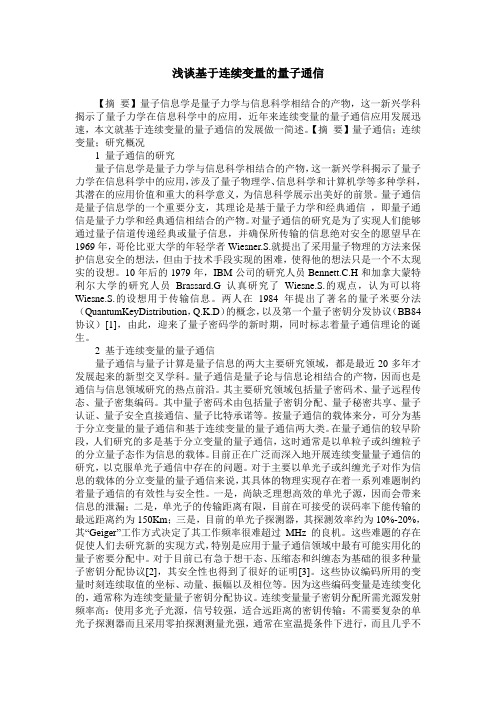
浅谈基于连续变量的量子通信【摘要】量子信息学是量子力学与信息科学相结合的产物,这一新兴学科揭示了量子力学在信息科学中的应用,近年来连续变量的量子通信应用发展迅速,本文就基于连续变量的量子通信的发展做一简述。
【摘要】量子通信;连续变量;研究概况1 量子通信的研究量子信息学是量子力学与信息科学相结合的产物,这一新兴学科揭示了量子力学在信息科学中的应用,涉及了量子物理学、信息科学和计算机学等多种学科,其潜在的应用价值和重大的科学意义,为信息科学展示出美好的前景。
量子通信是量子信息学的一个重要分支,其理论是基于量子力学和经典通信,即量子通信是量子力学和经典通信相结合的产物。
对量子通信的研究是为了实现人们能够通过量子信道传递经典或量子信息,并确保所传输的信息绝对安全的愿望早在1969年,哥伦比亚大学的年轻学者Wiesner.S.就提出了采用量子物理的方法来保护信息安全的想法,但由于技术手段实现的困难,使得他的想法只是一个不太现实的设想。
10年后的1979年,IBM公司的研究人员Bennett.C.H和加拿大蒙特利尔大学的研究人员Brassard.G认真研究了Wiesne.S.的观点,认为可以将Wiesne.S.的设想用于传输信息。
两人在1984年提出了著名的量子米要分法(QuantumKeyDistribution,Q.K.D)的概念,以及第一个量子密钥分发协议(BB84协议)[1],由此,迎来了量子密码学的新时期,同时标志着量子通信理论的诞生。
2 基于连续变量的量子通信量子通信与量子计算是量子信息的两大主要研究领域,都是最近20多年才发展起来的新型交叉学科。
量子通信是量子论与信息论相结合的产物,因而也是通信与信息领域研究的热点前沿。
其主要研究领域包括量子密码术、量子远程传态、量子密集编码。
其中量子密码术由包括量子密钥分配、量子秘密共享、量子认证、量子安全直接通信、量子比特承诺等。
按量子通信的载体来分,可分为基于分立变量的量子通信和基于连续变量的量子通信两大类。
- 1、下载文档前请自行甄别文档内容的完整性,平台不提供额外的编辑、内容补充、找答案等附加服务。
- 2、"仅部分预览"的文档,不可在线预览部分如存在完整性等问题,可反馈申请退款(可完整预览的文档不适用该条件!)。
- 3、如文档侵犯您的权益,请联系客服反馈,我们会尽快为您处理(人工客服工作时间:9:00-18:30)。
专题报道/Cover FeaturesCommunications of CCF 2008/7 58连续变量量子信息苏晓龙谢常德彭堃墀引言1948年,美国工程师香农(C. E.Shannon[1])发表了《通信的数学理论》一文。
该文对信息给予了定量的描述,标志着信息学科的确立。
20世纪后期,人类社会已经进入信息化时代。
谁能最快、最准确地掌握相关信息,谁就会在社会活动中处于主动地位。
无论是在国家安全、政府决策、商业活动和工业生产,还是在日常生活和科学研究中,信息的交换使用及其安全传输无处不在。
信息对当代社会的进步产生了广泛的影响和巨大的推动作用,人类社会的存在和发展已经进入了时刻都离不开信息的时代。
量子力学理论从20世纪20年代诞生至今,已经取得了巨大的成功。
该理论不仅成功解释了原子和原子核结构、固体结构和半导体性质等重要物理问题,而且也促进了现代微电子技术、激光技术、新能源技术和新材料科学的出现和发展。
但是在20世纪80年代以前,几乎无人注意到经典信息理论和量子力学理论之间的交叉。
直到最近20多年来,人们才越来越清楚地认识到它们之间存在着深刻密切的联系,由此产生了内容丰富的量子信息学[2,3]。
量子信息学作为量子物理学与计算机科学、信息科学相结合的新兴学科,提出了一整套以量子力学的基本原理为基础,通过量子系统的各种相干特性(量子叠加、量子并行、量子纠缠和量子不可克隆等等)进行计算、编码和信息传输的全新方式。
量子信息技术包括量子通信和量子计算两部分内容。
量子力学与信息科学的结合不仅充分显示了学科交叉的重要性,而且也表明量子信息技术的最终物理实现会导致信息科学观念和模式的重大变革。
量子信息学是一个相对年轻的学科,一方面赋予信息科学新的生命力,另一方面又可以反过来从信息理论的角度使量子物理的概念具体化,从而给予量子理论更深层次的理解[3]。
现有的信息存储、处理和传输都依赖于经典物理系统,以经典物理概念为基础和出发点,而量子信息技术则是以量子物理概念为基本出发点。
量子信息科学根据量子系统本征态所具有的离散谱和连续谱两种结构特征,可分为离散变量的与连续变量的两大类。
其中,离散变量是指能够用可数(有限)维希尔伯特空间表征的量子变量,如光子或光波场的偏振。
连续变量是指这样一类量子变量,它们的每一个值对应不同的正交本征态,这些本征态构成无限维希尔伯特空间,比如粒子的位置与动量、光波场的正交振幅与正交位相分量等。
量子信息科学首先在离散变量领域提出和发展[2],后来扩展到连续变量领域[3]。
量子纠缠量子力学所提供的最重要的“资源”是量子纠缠(Quantum Entanglement)。
正是利用了纠缠,人们才得以突破经典电动力山西大学关键词:连续变量 量子纠缠学的框架,从全新的视角去发展信息科学与技术,完成一系列经典通信不可能完成的工作。
其中最引人注目的是量子离物传送(Quantum Teleportation)与量子密集编码(Quantum Dense Coding)。
前者实现了未知量子态从一处到另一处的远程离物传送,后者使通信系统的信道容量突破了经典光通信的最大极限。
量子纠缠是量子系统独有的特性,反映了系统中子系统之间的相关性与不可分性。
当两个或两个以上的子系统构成的量子体系的态矢量1,在任何量子力学表象中都无法表示为组成它的各子系统量子态矢的直积形式时,这些子系统之间则表现出相互纠缠的不可分特性,即使将它们空间分离,对一个子系统的观测也必然影响其它子系统的测量结果。
这种相互依存的非定域关联称为量子纠缠,简称纠缠。
二粒子系统的纠缠概念最早以1935年爱因斯坦(E i n s t e i n)、波多尔斯基(Podolsky)和罗森(Rosen)(简称EPR)三位科学家联合发表的著名论文[4]中提出,因此由2个子系统构成的纠缠态常常又称为“EPR”对。
虽然在EPR原始文献中,所讨论的可观测量子变量,是具有连续谱的正则坐标与动量,但是由于难以在量子水平上精确测定微观粒子的坐标与动量,所以早期验证EPR纠缠的实验都是用离散变量(粒子自旋或光子的偏振)实现的。
多组份纠缠态是相对于两组份EPR纠缠态而言的,是指纠缠由多于两个的子系统共享。
多组份纠缠态是研究量子通信网络和量子计算的基础。
其形式很多,目前研究的主要包括两大类:GHZ2纠缠态[5]和簇集(Cluster)纠缠态[6]。
两者的纠缠特性有所不同,簇集纠缠态的纠缠保持特性要优于GHZ纠缠态。
我们研究组于2003年完成了连续变量三组份GHZ纠缠态光场实验制备并完成了可控密集编码[7],2007年实验制备了连续变量四组份GHZ和簇集纠缠态光场[8]。
连续变量量子通信量子通信主要包括量子离物传送、量子密集编码和量子保密通信等。
发展至今,连续变量的量子离物传送、密集编码和保密通信的理论和原理性实验研究已完成。
连续变量量子离物传送利用一种超自然的力量(如在科幻小说中所说的)或现代科学技术手段,以尽可能快捷的方式将一个物体从某处(发送者)传送到空间远距离的另一地方(接收者),这就是最早提出的离物传送(Teleportation)概念。
与一般客体的输运不同,量子离物传送(Quantum Teleportation)是将一个未知的量子态从客体中分离出来,再由一个地方传送至另一个地方。
经典物理学认为,传送一个物体就是传送组成它的全部经典物理特征。
只要精确测量构成物体的所有信息,并以不超过光速极限的速度将它们传至遥远的接收站,并用得到的信息将完全类同于被传送客体的复制品重构出来,即完成经典客体的离物传送,可以通过经典物理信道实现,如电话、传真和网络等。
在量子理论中,一个微观客体的测量与传输即量子态的测量与传输。
而海森伯不确定原理3告诉我们,要完全精确测量一个未知量子体系的状态是不可能的,同时伍特-祖瑞克(Wootter-Zurek)非克隆定理[9]也指出一个量子态不可精确克隆。
量子离物传送与不可克隆定理之间显然存在着根本的矛盾,因而用常规方法无法实现一个量子客体的离物传送。
1993年,班尼特(C. H. Bennett)等来1态矢量的概念来源于统计物理学,是对连续的物理场进行粗粒化描述的方法2 Greenberg Horne-Zeilinger,格林伯格-霍姆-泽林格3 Werner Karl Heisenberg (1907~1976),亦译成海森堡,德国理论物理学家,量子力学的重要奠基人。
以其名字命名的不确定原理又称测不准原理。
该原理指出:一个微观粒子的某些物理量(如位置和动量,或方位角与动量矩,还有时间和能量等),不可能同时具有确定的数值,其中一个量越确定,另一个量的不确定程度就越大。
测量一对共轭量的误差的乘积必然大于常数 h/2π(h是普朗克常数)Communications of CCF 2008/759专题报道/Cover FeaturesCommunications of CCF 2008/760自4个国家的6位科学家联合发表了题为《经由经典和EPR 信道传送未知量子态》的具有开创性的文章,提出了一个量子离物传送的方案,其目标是利用纠缠和经典比特传输量子态,并且在接收方重构量子态。
其基本思想是[2]:将原物的信息分成经典信息和量子信息两部分,它们分别由经典通道和量子通道传送给接收者。
经典信息是发送者对原物进行某种测量而获得的。
量子信息是发送者在测量中未提取的其余信息,是利用非局域量子纠缠和纠缠塌缩来进行直接传送的。
接收者在获得这两种信息之后,就可以制造出原物的完美复制品。
在此过程中,原物未被传送给接收者,所传送的仅仅是原物的量子态,因此称之为量子态的离物传送。
原物的量子态对发送者来说甚至可以一无所知,原物的量子态在发送者进行测量和提取经典信息时已遭受破坏,接收者在恢复原物量子态时将别的粒子(甚至可以是与原物不相同的粒子)置于原物的量子态上,因此恢复的过程就是量子态的重构。
由于原始量子态已在传送过程中遭到摧毁,所以此过程不违背量子不可克隆定理。
此外,经典信息对量子态的重构也必不可少,由于经典信息的传送速度不可能快于光速,因此量子离物传送也不违背相对论的光速最大原理。
1998年,美国的金布尔(H. J. Kimble )小组利用2个相位相干的正交位相压缩光,在50%分束器上耦合产生了一对连续变量的EPR 纠缠光束,因而首先完成了连续变量的量子离物传送实验[10]。
2003年,该小组在改进了量子离物传送实验后,实现了保真度为0.61±0.02的量子态离物传送[11]。
澳大利亚国立大学的兰姆(P.K. Lam )研究组,利用两个经典相干量子独立的压缩光和分束器产生了明亮EPR 纠缠态,并将其用于实现量子离物传送(保真度为0.64±0.02)[12]。
我们实验室利用由双KTP 4晶体构建的NOPA 5 所产生的明亮EPR 纠缠光束,初步完成了相干态的量子离物传送,保真度达到0.58[13]。
图1 连续变量量子离物传送态示意图4 KTiOPO4,磷酸氧钛钾5 non-degenerate optical parametric ampli fier ,非简并光参量放大器6 optical parametric oscillator图1简要介绍了连续变量的量子离物传送实验 [10]。
通过双向泵浦的光学参量振荡器(OPO 6),产生两个独立的正交位相压缩真空态光场,然后经50%光学分束器合成一对EPR 纠缠态光场1和2。
在发送站,发送者艾丽丝(Alice )用一个50%分束器将EPR1与待传未知量子态 进行耦合,2个输出场被送入平衡零差探测器Dx 和Dp ,分别测量正交振幅和正交位相,以完成连续变量的贝尔(Bell )态测量。
如果EPR1和EPR2是理想纠缠态,此时EPR1具有无限大的量子起伏,艾丽丝不可能测得 的任何信息。
然而在这一耦合测量过程中,量子态 的量子信息,就会经消纠缠塌缩“无形”地传送给EPR2,这正是信息传送的量子通道。
此时,EPR2的状态与初始 态仅差一个相空间的平移因子。
为了确切地再现初始态,接收者鲍勃(Bob )利用经典通道传送过来的艾丽丝对正交振幅和正交位相的测量结果,即光电流 和 ,经振幅(Mx )和位相(Mp )调制器调制一束相干光,之后通过高反镜mBob 与EPR2干涉耦合,in V in V in VCommunications of CCF 2008/761图2 连续变量量子密集编码原理这一步相当于EPR2的简单的相空间平移。
最后,配置者维克托(Victor )利用平衡零差探测系统对输出场进行检测。
没有量子纠缠时,保真度最高只能达到0.5,EPR1和EPR2进行部分纠缠时,保真度超过0.5。
